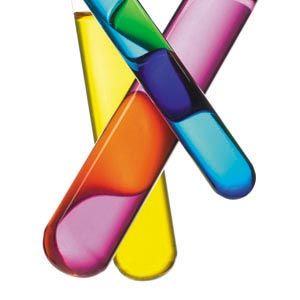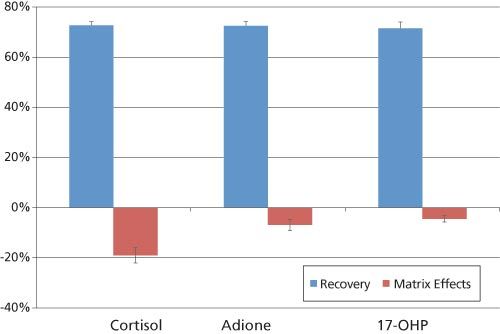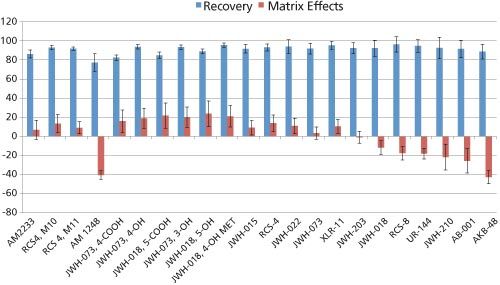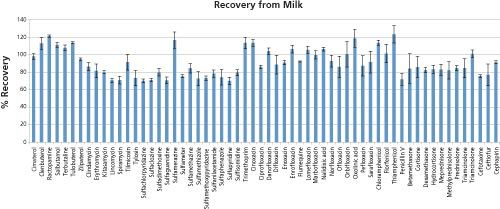Advances in Sample Preparation: Removing Phospholipids from Biological Samples
The Column
Advances in Sample Preparation: Removing Phospholipids from Biological Samples
Solid-phase extraction (SPE) has long been used for sample preparation - and is often chosen over liquid–liquid extraction (LLE) - because it can efficiently clean up and concentrate analytes of interest without the use of the more toxic organic solvents. This article describes the properties and use of a new SPE sorbent that removes phospholipids from biological samples, and illustrates the benefits of this approach with practical examples.
Photo Credit: Science Photo Library/Getty Images

Reversed-phase solid-phase extraction (SPE) has long been a staple of bioanalytical and environmental analysis because it is relatively simple to perform.1–3 A sample is loaded on to a reversed-phase sorbent (often in a primarily aqueous medium), and, because the compounds of interest are generally hydrophobic, they bind to the sorbent preferentially over the aqueous media. The sorbent is then rinsed or washed with an aqueous solution containing a low percentage of water miscible organic solvent (such as methanol) to remove salts, polar matrix compounds, and other interfering components. Finally, the analytes of interest are eluted from the sorbent with an organic solvent, at which point they can be either analyzed directly, or dried down and reconstituted in an appropriate solution. There are myriad variations on this technique. By customizing sample pretreatment, pH, and the percentage and nature of the organic solvents used for washing and elution, SPE can be an extremely versatile, specific, and powerful technique for extracting and concentrating a variety of analytes from complex matrices.
Early reversed-phase SPE sorbents consisted of inorganic base-particles; for example, silica bonded with a hydrophobic phase such as C18 hydrocarbon chains. Silica-based SPE sorbents can be modified in a number of ways, such as changing the length or nature of the bonded phase (for example, C8 versus C18; cyanopropyl or diol versus hydrocarbon). More recently introduced reversed-phase stationary phases are polymeric in nature, often consisting of polymerized divinylbenzene that can be modified on the surface or incorporate additional monomers to improve performance or enhance the retention of specific chemical classes.
Despite the development of highly specific extraction methods, one common challenge is the presence of phospholipids in many biological samples. These components of the lipid bilayer of cell membranes include phosphatidylcholines, lysophosphatidylcholines, phosphatidylinositols, and sphingomyelines, to name a few.4 Phospholipids can contribute significantly to adverse matrix effects in liquid chromatography–mass spectrometry (LC–MS) analyses.5–7 This can become an even more significant issue with food safety applications, using matrices such as meat or milk, in which up to 15–20% of the wet weight of the sample is composed of fats and up to 3% consists of phospholipids. In addition to the adverse effects these components have on electrospray ionization (ESI), the accumulation of phospholipids on LC columns and ionization sources can lead to reduced column lifetimes and more frequent MS maintenance.
A new reversed-phase SPE sorbent has now been developed that combines the “catch and release” properties of reversedâphase SPE with the ability to simultaneously remove phospholipids from biological samples. It also shares many properties with other polymeric, reversedâphase sorbents including water wettability, enabling the direct loading of aqueous samples without the need to condition or equilibrate the sorbent. This approach can save time and simplifies the sample preparation workflow, but also eliminates the risk of analyte retention loss during the extraction process, should an individual cartridge or well within a plate dry out during the conditioning or equilibration steps. This article describes the performance of this novel sorbent, and provides specific analytical examples.
Materials and Methods
Oasis PRiME HLB cartridges and plates (Waters Corporation) were used for all solid-phase extractions. ACQUITY/Xevo UPLC–MS–MS systems were from Waters Corporation. All solvents (acetonitrile, methanol, isopropanol) were Optima grade and were obtained from Fisher.
Extraction and Analysis of Corticosteroids from Plasma:Sample Preparation: Samples were prepared as follows: Plasma samples of 150 μL were precipitated with 300 μL of a solution of 4:1 methanol:89 g/L ZnSO4 and then centrifuged. A volume of 300 μL of the resulting supernatant was then added to 900 μL of 4% H3PO4 and aspirated to fully mix the sample. The resulting pretreated sample was then directly applied to the wells of a micro elution plate. All wells of the SPE plate were then washed with 2 × 200 μL aliquots of 25% methanol. The samples were then eluted with 2 × 25 μL aliquots of 90:10 acetonitrile: methanol and diluted with 25 μL of water. 7.5 μL was injected onto the UHPLC–MS–MS system.
Extraction and Analysis of Synthetic Cannabinoids and Metabolites from Whole Blood:
Sample Preparation: Samples were extracted using the novel sorbent in 30 mg plate format. A 100-μL solution of 0.1 M zinc sulphate/0.1 M ammonium acetate was added to 100 μL of whole blood, and vortexed for 5 s to lyse the cells. All samples were then precipitated by adding 400 μL acetonitrile. The entire sample was vortexed for 10 s and centrifuged. The supernatant was then diluted with 1.2 mL water and directly loaded on to the 30 mg plate. All wells were then washed with 2 × 500 μL 25:75 methanol:water, and eluted with 2 × 500 μL 90/10 acetonitrile/methanol. The eluate was then evaporated under nitrogen and reconstituted with 100 μL 30% acetonitrile, and 5 μL was injected onto the UHPLC–MS–MS system.
Analysis of Veterinary Drugs in Milk:Sample Extraction: 4 mL of 0.2% formic acid (FA) in acetonitrile was added to 1 mL of milk and thoroughly mixed. Samples were centrifuged for 5 min at 10,000 rpm. Aliquots of the supernatant were used for SPE cleanup.
Solid-Phase Extraction (SPE) Cleanup: 3 cc (60 mg) SPE cartridges were prepared by conditioning with 3 mL 0.2% formic acid in acetonitrile. (Note: This conditioning step is only required if gravity loading is desired. This step is not necessary if a sample is processed with minimal vacuum). The supernatant was passed through the cartridge and collected, then evaporated to dryness under a gentle nitrogen stream. After reconstitution in 1 mL of 5% methanol in water, the samples were filtered and transferred to a vial for UHPLC–MS–MS analysis.
Analysis of Veterinary Drugs in Salmon:
Sample Extraction: A sample of 2.5 g of homogenized tissue was placed in a 50 mL centrifuge tube. A solution of 10 mL 80:20 acetonitrile:water with 0.2% formic acid was added, and the samples were vortexed for 30 s, agitated on a mechanical shaker for 30 min and then centrifuged at 12,000 rpm for 5 min.
Solid-Phase Extraction (SPE) Cleanup: The resulting 0.5 mL supernatant was directly loaded onto the SPE cartridge (3 cc, 60 mg) and drawn through the sorbent under a gentle vacuum. No conditioning or equilibration was performed. The 300 μL eluate was then diluted with 600 μL of 10 mM NH4COOH (pH 4.5) and analyzed by UHPLC–MS–MS.
Results and Discussion
Extraction of Corticosteroids from Plasma: Figure 1 illustrates the recovery and matrix effects seen for corticosteroids after extraction from plasma. Extraction recoveries ranged from 72–73% with %RSDs under 5%. The matrix effect for cortisol was -19%, indicating minor ion suppression, and was minimal for the other compounds. The average matrix effect for all three compounds was -10.1%. Standard deviations for matrix effects were 3.1% or less. This method was also assessed for accuracy and precision. R2 values for all three analytes were 0.99 or greater with mean percentage deviations of <10% for all calibration points. Quality control results are listed in Table 1. All results had accuracies within 10% of target values and %CVs less than 7%.

Figure 1: Recovery and matrix effects from the extraction of corticosteroids from plasma. Adione and 17-OHP refer to androstenedione and 17α-OH progesterone, respectively. Samples were extracted as described in the Materials and Methods section. (N = 4).

Extraction of Synthetic Cannabinoids from Whole Blood: A different bioanalytical matrix and method were evaluated by extracting a panel of synthetic cannabinoids and metabolites from whole blood. These compounds have proliferated drastically over recent years and represent a rapidly growing issue for medical examiners and forensic toxicology laboratories.8 This panel represents several classes of these compounds including adamantoylindoles, napthoylindoles, phenylacetyl indoles, and tetramethylcyclopropylindoles. Major hydroxylated and carboxylated metabolites of JWH-073 and JWH-018 were also included because these compounds are rapidly metabolized in vivo.9–11 Whole blood samples were prepared as described in the materials and methods section. Figure 2 summarizes the recovery and matrix effects seen across this entire panel. The average recovery was 91% with only a single analyte under 80%. Once again, these results were consistent, with %RSDs ranging from 2.2–12.2% and averaging 5.8%.
Figure 2: Recovery and matrix effects from the extraction of synthetic cannabinoids and metabolites from whole blood. Samples were extracted as described in the Materials and Methods section. (N = 4). Average recoveries were 91%. The average magnitude of matrix effects was 17%.

Figure 3 demonstrates the removal of endogenous phospholipids from the plasma and whole blood samples described above. Comparing the peak areas of remaining phospholipids revealed that >95% were removed from both plasma and whole blood samples.
Figure 3: Residual phospholipids in plasma and whole blood extracts. (a): Residual phospholipids in plasma samples extracted with cartridges (top) and identical samples processed by simple protein precipitation (bottom). Compared to PPT, SPE eliminated >97% of phospholipids from plasma samples. (b). Residual phospholipids in whole blood samples. Compared to PPT, SPE eliminated >95% of phospholipids from whole blood samples.

Direct evidence of the impact of phospholipid removal was seen with the synthetic cannabinoid JWH 203. Under these conditions, this compound coâelutes with the putative phospholipid lysoâphosphatidylcholine 18:0 (LPC 524) at 5.7 min.4 This corresponds to the final phospholipid peak in Figure 3(b). Figure 2 shows that matrix effects are minimal for JWH-203 using the phospholipid-removing sorbent. However, when the synthetic cannabinoid, JWH 203, was extracted from whole blood using a polymeric reversed-phase sorbent that does not remove phospholipids, ion suppression was increased to -94%, demonstrating the direct and deleterious effect that phospholipids can have in bioanalysis. Other polymeric reversed-phase sorbents showed an almost identical correlation between PL 524 abundance and ion suppression for this compound, revealing a direct and quantifiable correlation between the presence of phospholipids and ion suppression.
Two food safety applications were also assessed using this new sorbent, both pass through cleanup methods for multi-residue veterinary drugs in milk and salmon. In these cases, phospholipids can be present in substantially higher concentrations than in blood or plasma and have the potential to create even greater problems with matrix effects and system cleanliness.
Multiresidue Cleanup of Whole Milk: Whole milk is a complicated matrix, containing large amounts of proteins, fats, and phospholipids that can interfere with the detection and quantification of target analytes. It is essential to isolate the compounds of interest in milk from lipids and proteins, just as one does in other matrices. Milk samples were prepared as described above and passed through 3 cc (60 mg) SPE cartridges to remove fats, phospholipids, proteins, and other matrix components. The results from this extraction are shown in Figure 4(a). These 60 compounds represent nine different classes of veterinary drugs, including sulphonamindes, fluoroquinolones, β-agonists, macrolides, glucocorticoids, amphenicols, β-lactams, cephalosporins, and tetracyclines. Recoveries ranged from 70–120% with an average recovery of 91%. Recoveries were reproducible, with %RSDs ranging from 1–18% with a mean of 7.4%. As with the bioanalytical methods, this method removed >90% of phospholipids from milk samples.
Figure 4: (a) Recoveries of veterinary drugs from milk samples following protein precipitation and pass through SPE cleanup (N = 5). The recoveries represent total method recovery (PPT and SPE). Actual loss from SPE was less than 5% for all compounds.

Figure 4: (b) Recoveries of veterinary drugs from salmon samples following protein precipitation and pass through SPE cleanup (N = 5). The recoveries represent total method recovery (PPT and SPE). Method recovery refers to the extraction efficiency of the entire method. Extraction recovery refers to the extraction efficiency of the pass-through SPE procedure.

Multiresidue Cleanup of Salmon: The final example involves the extraction of veterinary drugs from salmon. Like the whole milk example, this represents a pass through method designed to trap fats, phospholipids, and other matrix components from precipitated supernatants.
Figure 4(b) shows recovery results of the pass through method used for salmon. Both method recovery (blue) and extraction efficiency (red) are shown. The method recovery data refers to the efficiency of the entire method, including precipitation and pass through SPE using 3 cc (60 mg) cartridges. The method recovery was quite good, ranging from 51% to 95% with an average of 79%. The pass through recovery data only represents the extraction efficiency of the sorbent and shows that the average recovery for this panel of compounds was 97% with an average %RSD of 3.5%. Once again, assessment of remaining phospholipds revealed that this pass through SPE method removed >90% of phospholipids from the sample compared to the total phospholipids remaining after SPE cleanup with a traditional C18 sorbent.
Conclusion
This article reviews the results obtained with a reversed-phase sorbent that is water wettable and can eliminate phospholipids and many fats from biological samples. Four different examples are shown that demonstrate performance in a variety of matrices, including plasma, whole blood, milk, and salmon. These examples also represent a variety of different compounds, including steroids, synthetic cannabinoids, and veterinary drugs. Despite the variety of matrices and target compounds, use of this sorbent resulted in high and reproducible recoveries with relatively low matrix effects. Both SPE methods used the same elution solvent: 90/10 acetonitrile/methanol. Both pass through methods used supernatants containing about 80% acetonitrile. Phospholipids were nearly eliminated when compared to protein precipitation or other reversed-phase SPE techniques. This led, in one particular example, to the elimination of 94% ion suppression for a compound that co-eluted with a large phospholipid peak.
In summary, water-wettability and the ability to nearly eliminate residual phospholipids represent an improvement in reversed-phase SPE technology that
can help scientists to improve their analytical methods. The examples described here can be used as a guide for similar matrices.
References
1. J. Henion, E. Brewer, and G. Rule, Analytical Chemistry70(19), 650A–656A (1998).
2. R.E. Majors, LCGC North America 20(12), 1098–1113 (2002).
3. B. Buszewski and M. Szultka, Critical Reviews in Analytical Chemistry42(3), 198–213 (2012).
4. M. Dashti, W. Kulik, F. Hoek, E.C. Veerman, M.P. Peppelenbosch, and F. Rezaee, Scientific Reports 1, 139 (2011).
5. E. Chambers, D.M. Wagrowski-Diehl, Z. Lu, and J.R. Mazzeo, Journal of Chromatography B852(1–2), 22–34 (2007).
6. W. Jian, R.W. Edom, Y. Xu, and N. Weng, Journal of Separation Science33(6–7), 681–697 (2010).
7. Y.-Q. Xia and M. Jemal, Rapid Communications in Mass Spectrometry 23(14), 2125–2138 (2009).
8. K.A. Seely, J. Lapoint, J.H. Moran, and L. Fattore, Progress in Neuro-Psychopharmacology and Biological Psychiatry39(2), 234–243 (2012).
9. K.C. Chimalakonda, K.A. Seely, S.M. Bratton, et al., Drug Metabolism and Disposition40(11), 2174–2184 (2012).
10. C.L. Moran, V.-H. Le, K.C. Chimalakonda, et al., Analytical Chemistry83(11), 4228–4236 (2011).
11. T. Sobolevsky, I. Prasolov, and G. Rodchenkov, Forensic Science International200(1), 141–147 (2010).
Dr. Jonathan Danaceau is a senior applications chemist in the Consumables Business unit of Waters Corporation. He received a B.S. in biology from Allegheny College and a Ph.D. in neuroscience from the University of Utah. He is currently focused on the development of clinical research and forensic toxicology methods employing sample preparation and LC–MS–MS.
Jamela Iraneta is a principal scientist in the Consumables Business Unit of Waters Corporation. She has a B.S. in chemistry from The College of William and Mary and a B.S.E.E. in electrical engineering from Northeastern University. She is the co-author of several publications and has a co-inventor on several patents. She is currently focused on the development of novel sample preparation sorbents and techniques.
Dr. Xin Zhang is currently a senior research chemist in the Consumables Business Unit at Waters Corporation. She received her Ph.D. degree in analytical chemistry from The State University of New York at Buffalo in 2007. She has been focused on the evaluation and development of different sample preparation products and techniques.
Kim Haynes is currently a senior product marketing manager for the sample preparation business in the Consumables Business Unit of Waters Corporation. She holds a BS in chemistry from Ohio University. Kim is focused on helping her customers and colleagues understand chromatographic separations and sample preparation. Before joining Waters Corporation, Kim worked as an analytical chemist at Bacardi Martini.
Dr. Erin Chambers is a principal scientist and the Director of the Technology Advancement division of Waters Consumable Business Unit. She received her B.S. in chemistry from Yale University and her Ph.D. in analytical chemistry from King’s College in London. Her current research focuses on the bioanalysis of peptides and proteins using SPE and LC–MS–MS.
Dr. Michael S. Young is a principal chemist and applications manager in the Consumables Business Unit at Waters Corporation. He received his B.S. and Ph.D. in chemistry from the University of Massachusetts. His current research focuses on the development of environmental and food safety applications using mass spectrometry.
Kim Tran is a chemist II in the Consumables Business Unit at Waters Corporation. Her current research focuses on the development of environmental and food safety applications using mass spectrometry.
E-mail:
jonathan_danaceau@waters.com
Website:
www.waters.com
This article was featured in LCGC's digital magazine, The Column. Click here to view the full issue>>

Removing Double-Stranded RNA Impurities Using Chromatography
April 8th 2025Researchers from Agency for Science, Technology and Research in Singapore recently published a review article exploring how chromatography can be used to remove double-stranded RNA impurities during mRNA therapeutics production.









